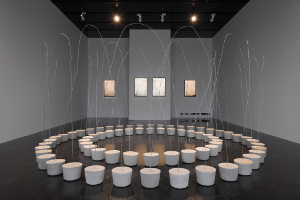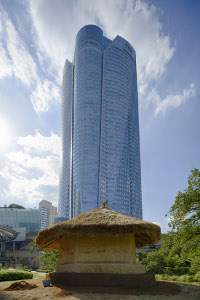The noteworthy third part of "Roppongi Crossing 2013: OUT OF DOUBT" is titled "The Japanese View of Nature and Invisible Energy." What the Great East Japan Earthquake and tsunami in northeastern Japan showed us was that nature is a much mightier force than anything created by man. In the same way that Japanese people have since ancient times seen gods or something celestial in natural phenomena, rocks, trees and mountains, they have also sensed the invisible energy within nature.
While the aftermath of the Great East Japan Earthquake and the Fukushima nuclear power plant accident have revealed to us the limits of societal values that place rationality and economy above all else, the Earthquake and Tsunami has triggered us to open our eyes to the ancient Japanese view of nature and of religion, and of invisible energy. It is also something that causes us to think about the various elements that control the universe such as the earth, water, fire, wind and the void space and their relationships. The ancient monistic idea that various different elements maintain the balance of the universe is a valuable perspective that Japan and the rest of Asia can share with the world.
"OUT OF DOUBT" presents a new work by Suga Kishio (born 1944), one of the best-known artists from the "Mono-ha" movement, a new trend in sculpture seen in the late 1960s, that leads us to think about connectivity, continuity, and the meaning of "void." We also present the work of Nakamura Yuta (born 1983) who considers ceramics from a social history of tiles, Mitsuta Haruo (born 1980) who has adopted the tradition of jizai-okimono from the mid-Edo period, and Iwata Sohei (born 1973) who makes us reconsider the meaning of urbanization and modernization through the activities of the ethnic minority Santal people of India. It is also an example of where the younger generation of Japan, with the traditional view of nature and animistic beliefs as their starting point, is rethinking the process of modernization and what has been lost by that process.

"Roppongi Crossing 2013: OUT OF DOUBT"
Installation view: Mori Art Museum
Suga Kishio
Photo: Watanabe Osamu

"Roppongi Crossing 2013: OUT OF DOUBT"
Installation view: Mori Art Museum
Iwata Sohei × Prominority
Pavilion for Unexpected Guests
2013
Soil, straw, etc.
400×400×400 cm
Photo: Watanabe Osamu
Iwata Sohei and 5 members of the Santali ethnic minority of India are invited guests of the exhibition. A Santali house made from a traditional dirt wall method will be installed for the duration of the exhibition in the Mohri Garden of Roppongi Hills.
■Relevant information
・OUT OF DOUBT in a Minute - website top page
・OUT OF DOUBT in a Minute - Highlights (blog link)
(1) Turning points in society explored through art past and present
(2) A critical spirit revealed by "nonsense"?
(3) Questioning the meaning of modernization from the ancient Japanese view of nature
(4) The "post-object" tendency goes global
・Mori Art Museum 10th Anniversary Exhibition
"Roppongi Crossing 2013: OUT OF DOUBT"
Saturday, September 21, 2013 - Monday, January 13, 2014








